Red & White
The evolution of Arsenal kits.
An iconographic study of the team that has built the Arsenal brand Identity over the years.

The evolution of Arsenal kits.
An iconographic study of the team that has built the Arsenal brand Identity over the years.
This book is divided into a personal selection of eleven major ‘players’Iconic historical moments, sponsors and partners - that have helped make the Arsenal shirt one of the greatest.
1886-1970
1971-1981
1981-1986
1986-1994
1994-1999
1999-2002
2002-2006
2006-2014
Unidentified
2014-2019
2019 - present
1930/31, 1932/33, 1933/34, 1934/35, 1937/38, 1947/48, 1952/53, 1970/71, 1988/89, 1990/91
League 1997/98, 2001/02, 2003/04
1929/30, 1935/36, 1949/50, 1970/71, 1978/79, 1992/93, 1997/98, 2001/02, 2002/03, 2004/05, 2013/14, 2014/15, 2016/17, 2019/20
“The original kit was a dark red, with long sleeves, a collar and three buttons down the front.”
In the vast tapestry of football's rich history, few clubs have managed to carve out a distinct and unmistakable identity quite like Arsenal FC. Through their iconic shirts, Arsenal has woven a narrative that tells the story of a club steeped in tradition, resilience, and the pursuit of excellence. From the early days of humble beginnings to the global stage of modern football, Arsenal's shirts have played a pivotal role in shaping their unique identity and capturing the hearts of millions of fans around the world. At the core of this identity lies the deep connection between Arsenal and their shirts, a connection that goes far beyond mere fabric and design. To understand the significance of Arsenal’s shirts, we must delve into the roots of the club itself. Founded by a group of munitions workers in Woolwich,
South London, in 1886, Arsenal FC initially adopted a dark red shirt, a color reminiscent of the attire worn by the very factory workers who birthed the club. This choice of color not only paid homage to their industrial origins but also laid the foundation for the club’s enduring identity. As the decades rolled on, Arsenal’s shirts evolved and adapted, reflecting the changing times and the club’s growing stature. However, it was the introduction of sponsors that truly transformed Arsenal’s shirts into a canvas of identity. With each new sponsorship deal, the club forged a unique relationship, combining sporting excellence with commercial viability. These partnerships not only provided financial support but also became intrinsic to Arsenal’s image and global appeal.
“In late 1886, a gaggle of workers from the Woolwich Arsenal Armament Factory decided to form a football team. They called themselves Dial Square as a reference to the sundial at the top of the entrance to the factory.”

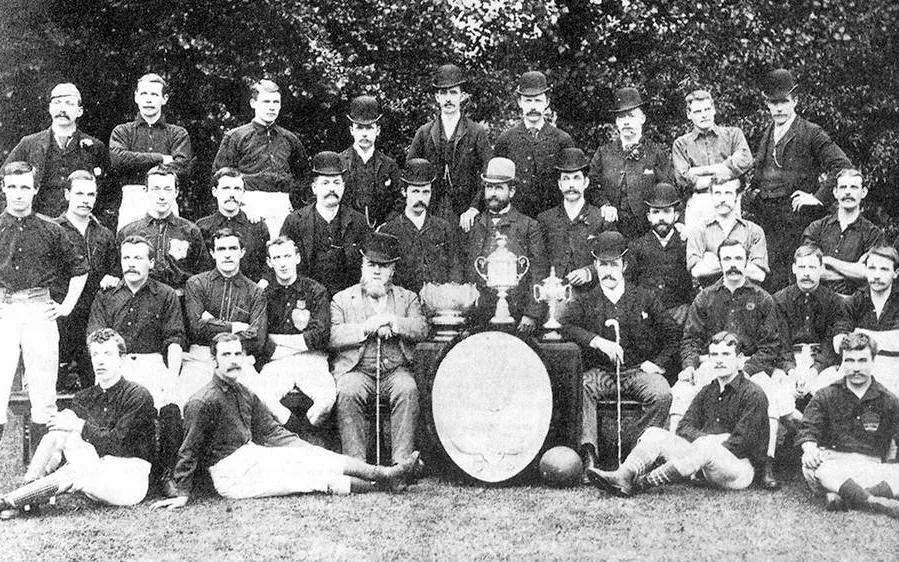
This book explores the captivating journey of Arsenal's shirts, tracing the iconic moments, the triumphs, and the challenges that have shaped the club's identity through sponsorship. From their early collaborations with brands such as JVC and Dreamcast to the modern-day partnerships with Puma and Adidas, each chapter delves into the design, significance, and impact of these iconic shirts. Beyond the fabric and colors, Arsenal’s shirts tell a story of unity, passion, and the unwavering dedication of players, managers, and supporters alike. They stand as
symbols of the club’s legacy and the indomitable spirit that has carried Arsenal through triumphs and setbacks. From the earliest days of dark red to the modern era of vibrant designs, Arsenal’s shirts have transcended the realms of sport, becoming a powerful medium through which, the club has connected with its global fan base. Through the lens of sponsorship, we delve into the rich tapestry of Arsenal’s shirts, celebrating the beauty, the passion, and the enduring legacy they have created for one of football’s most storied clubs.
“Arsenal's title triumph was the first by a team south of Birmingham and heralded five titles in eight seasons for the Gunners, the period that elevated them to the highest echelons of the game.”


In the history of Arsenal Football Club, few partnerships have had as profound an impact as the collaboration between the Gunners and sportswear manufacturer Umbro during the 1970s. This chapter explores how this iconic partnership not only shaped Arsenal's identity during that golden era but also set the foundation for the club's future success. The early
1970s marked a turning point for both Arsenal and Umbro. Arsenal, under the leadership of manager Bertie Mee, had experienced a period of relative mediocrity and sought to revitalize the club’s fortunes. Umbro, known for its quality sportswear and innovative designs, was looking to expand its presence in the football market. In 1971, these two powerhouses came together, giving birth to a partnership that would redefine Arsenal’s identity. One of the first significant changes brought about by the
Arsenal-Umbro partnership was the design of the team’s kit. Umbro introduced a bold and modern look, characterized by a prominent white sleeve with a red trim. This revolutionary design became instantly recognizable and resonated with the fans. The iconic Arsenal cannon emblem was prominently displayed on the chest, further solidifying the team’s identity.
“That was the longest three minutes I have ever known. As Tottenham came back, I remember thinking that perhaps it might have been better had my header not gone in.”
- Ray Kennedy
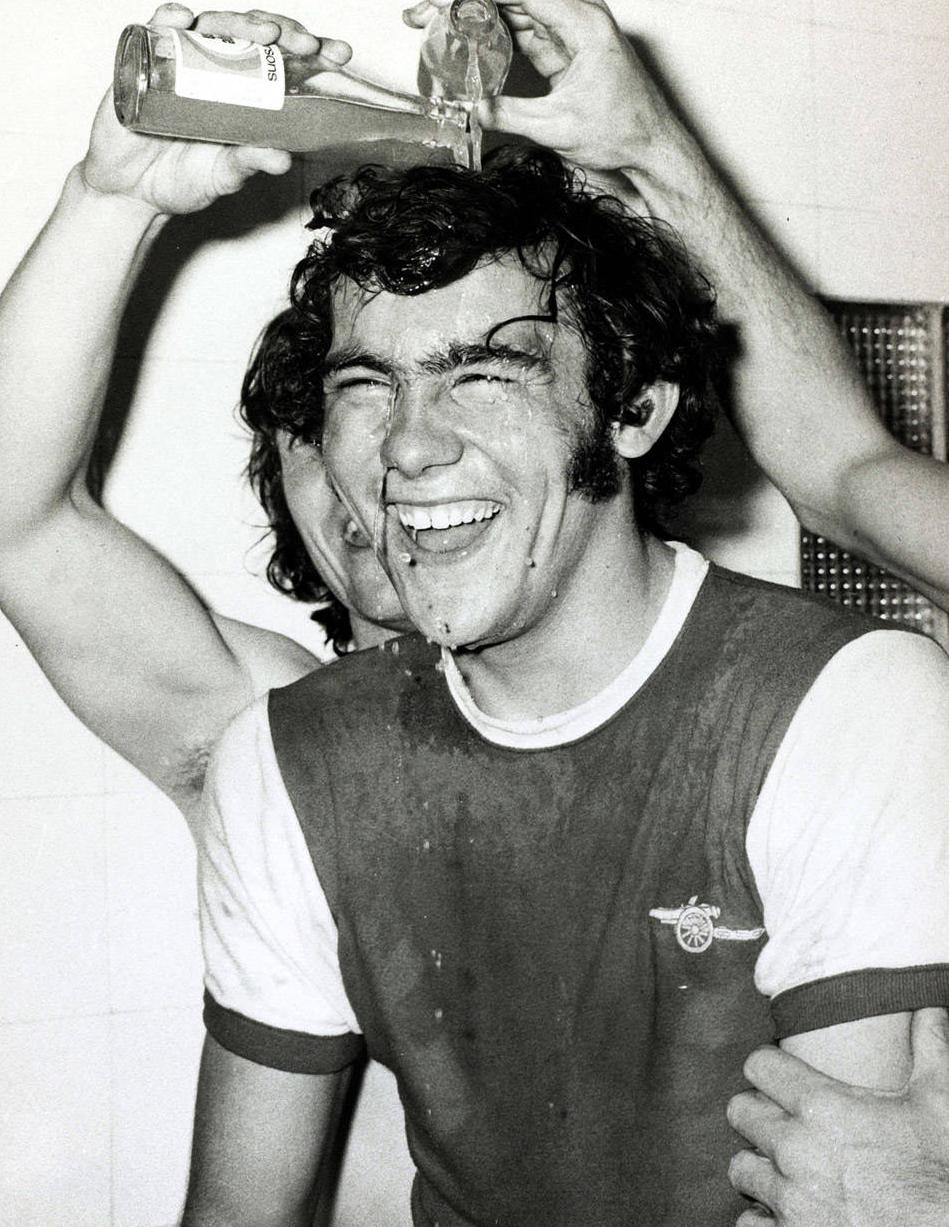
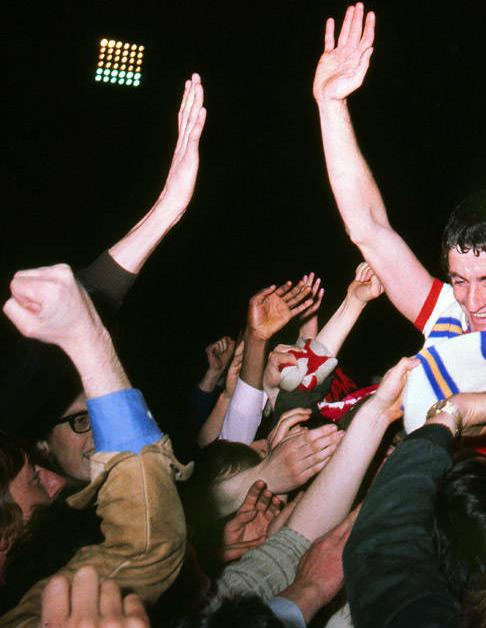

“As the ball hit the back of Liverpool's net, George sank to the Wembley turf and lay on his back with his arms outstretched.”
The 1970s marked a period of unprecedented success for Arsenal. Under the stewardship of manager Bertie Mee and the guidance of influential figures like captain Frank McLintock and striker Charlie George, the Gunners achieved remarkable feats. The team clinched their first-ever European trophy, the Inter-Cities Fairs Cup in 1970, followed by their first league and FA Cup double in the 1970-71 season. This success on the pitch helped to forge a winning mentality and a strong
sense of identity within the club. The partnership with Umbro extended beyond the football pitch, creating a cultural impact that resonated with fans. The new kit design and the team’s success captured the imagination of supporters, who proudly donned their replica shirts on match days. This sense of unity and identity spread throughout the fanbase, creating a powerful bond between the club and its followers. Arsenal became more than just a football team; it became a symbol of resilience, ambition, and community.
“His celebration remains one of the FA Cup's most iconic images.”
“I liked a fight and always stood up for myself. That’s how I was brought up. Coming from Holloway you learn from the pram to nut people that pick on you.”
- Charlie GeorgeCharlie George



The partnership between Arsenal and Umbro in the 1970s laid the groundwork for the club's future success and continued evolution. The triumphs of that era propelled Arsenal onto the international stage and attracted talented players and managers who would further shape the club's identity. Additionally, the strong bond formed with Umbro set the standard for subsequent partnerships, as the Gunners continued to collaborate with renowned sportswear brands, adapting
their kits while staying true to the club's core identity. The partnership between Umbro and Arsenal in the 1970s was a pivotal moment in the club’s history. Through innovative kit design, on-pitch triumphs, and a strong connection with fans, this collaboration helped shape Arsenal’s identity as a formidable force in English football. The legacy of that era continues to inspire and influence the club to this day, as Arsenal strives to uphold its rich heritage while embracing new partnerships and opportunities in an ever-evolving football landscape.




After the successful partnership with Umbro in the 1970s, Arsenal Football Club continued its quest for excellence by forging a new alliance with sportswear giant Adidas in the 1980s. This chapter explores how this collaboration not only shaped Arsenal's identity during a decade of dominance but also laid the foundation for the club's future achievements.
"Graham
Appointed in 1986, Graham brought a tactical discipline and defensive solidity to the team, revolutionizing their style of play. Under his guidance, Arsenal achieved remarkable success and solidified their identity as a resilient and tenacious side. Graham's meticulous approach, attention to detail, and ability to instill a winning mentality within the squad were instrumental in shaping Arsenal's identity during this period.

George Graham
was an uncompromising manager and instilled discipline and a strong work ethic from day one."
Adidas had firmly established itself as a global leader in sportswear. Known for their innovative designs and technological advancements, Adidas was the perfect partner to elevate Arsenal's image to new heights. The collaboration between the Gunners and Adidas symbolized a shared commitment to excellence and a desire to dominate
the football landscape. Adidas brought a fresh perspective to Arsenal’s kit design, incorporating their iconic three stripes into the shirt’s design. The classic red and white colors were maintained, but the introduction of new patterns and cuts modernized the appearance. The Adidas logo, displayed prominently on the
chest, became a symbol of quality and prestige. The new kit perfectly embodied the club’s ambition and desire to be at the forefront of football fashion.
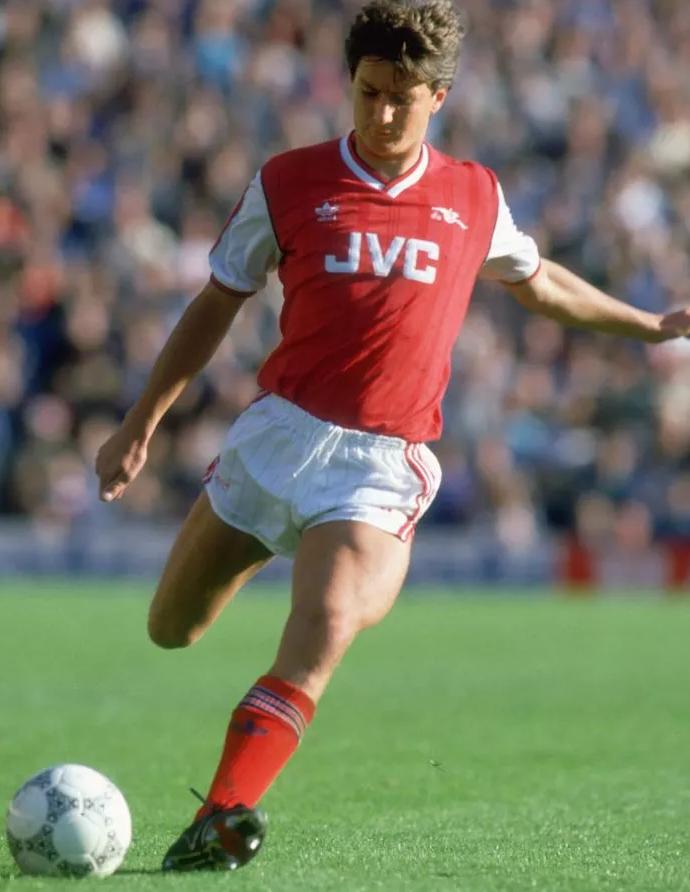
The partnership with Adidas in the 1980s coincided with a period of unparalleled success for Arsenal. Under the guidance of manager George Graham, the Gunners dominated English football. The team clinched two First Division titles, in 1988-89 and 1990-91, and also won the FA Cup twice during that period. The achievements on the pitch solidified Arsenal's identity as a team of winners and instilled a winning mentality within the club. Arsenal’s yellow JVC Adidas retro kits hold a special place in the hearts of fans, evoking
1986/88
a sense of nostalgia and reverence for a bygone era. Introduced in the late 1980s and early 1990s, these kits showcased a vibrant yellow color that became synonymous with the Gunners’ away matches. The JVC logo, displayed prominently on the front, added a touch of retro charm. These iconic kits represent a time when Arsenal’s dominance on the pitch and their unique sense of style converged, leaving an indelible mark on the
club’s identity. Today, these retro kits are cherished by fans as a symbol of Arsenal’s rich heritage and a reminder of the glorious moments they witnessed while wearing those colors.
“Play for the name on the front of the shirt and they’ll remember the name on the back.”
- Tony Adams

Arsenal's 1991 Adidas kit holds a special place in the club's history, representing a season of incredible success and glory. The kit itself featured a bold red design with white sleeves, showcasing a classic and timeless aesthetic. Under the guidance of manager George Graham, the Gunners achieved a remarkable double triumph, winning both the First Division title and the FA Cup. The team displayed a combination of defensive solidity, disciplined tactics, and clinical finishing that made them a force to be reckoned with. Players like Tony Adams, David Rocastle,
Ian Wright, and Paul Merson were instrumental in Arsenal's success that season, showcasing their skill, determination, and unwavering commitment to the club's cause. The 1991 season will forever be etched in Arsenal's history as a defining moment, and the Adidas kit worn during that campaign symbolizes the club's relentless pursuit of excellence and their ability to conquer all challenges in their path. Adidas’s global reach and marketing prowess helped Arsenal expand its fanbase beyond the United Kingdom. The partnership brought the Gunners
to the attention of football fans around the world, who admired the team’s stylish play and innovative kit designs. The iconic Adidas branding, combined with Arsenal’s success, made the club an aspirational brand for football enthusiasts everywhere. This increased international recognition bolstered Arsenal’s identity and influence on the global stage.


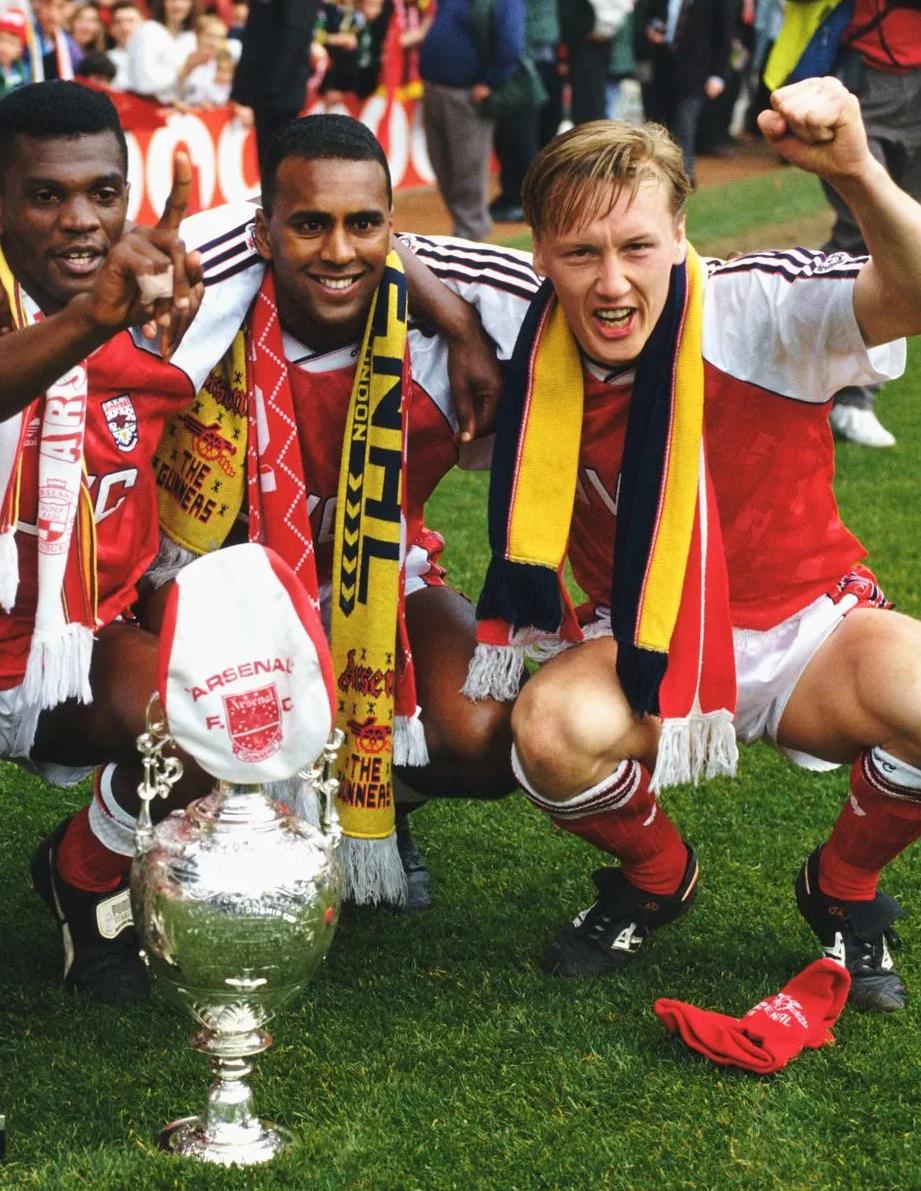
Arsenal's 1993 Adidas kit holds a special place in the club's illustrious history, representing a season of unrivaled glory and remarkable achievements. The kit featured a bold combination of navy blue and yellow, showcasing a vibrant and striking design that perfectly encapsulated the team's energy and ambition. Under the guidance of manager George Graham, the Gunners demonstrated their unwavering determination and resilience, securing both the League Cup and the UEFA Cup Winners' Cup. Players like Ian Wright, Tony Adams, and Paul Merson shone brightly,
showcasing their exceptional skills and contributing to the team's success. The 1993 season remains a testament to Arsenal's indomitable spirit and their ability to triumph on the grandest stage. The iconic Adidas kit worn during that historic campaign serves as a symbol of the club's rich heritage, resilience, and unwavering pursuit of greatness. The partnership between Arsenal and Adidas in the 1980s left an indelible mark on the club’s identity, shaping its future direction. The dominance and success of that era set a standard
for excellence that the Gunners have strived to maintain. Even after the partnership ended, the influence of Adidas remained, as subsequent collaborations with other sportswear brands followed in its footsteps, building on the foundation laid by the Adidas era.

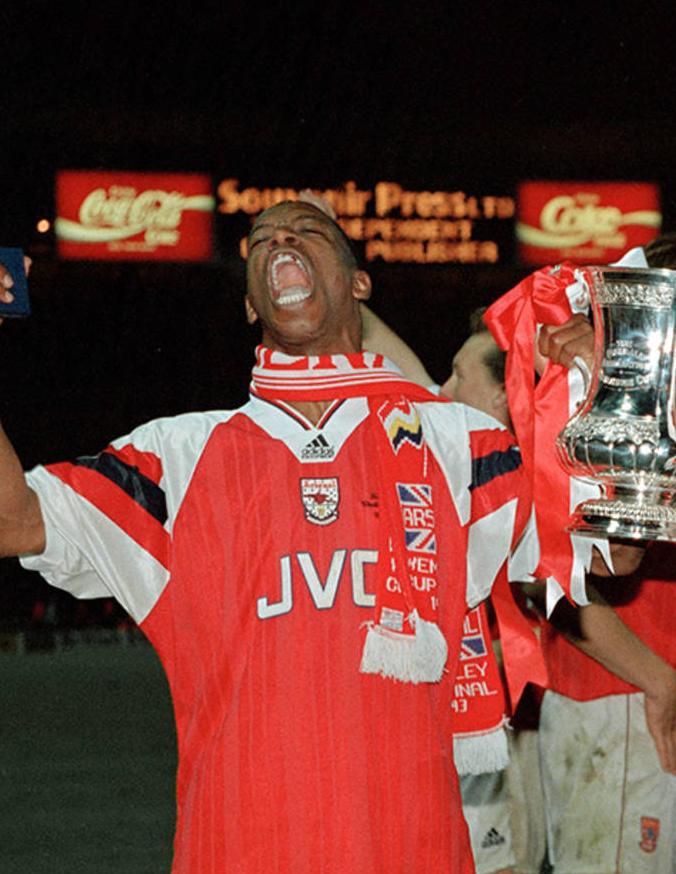
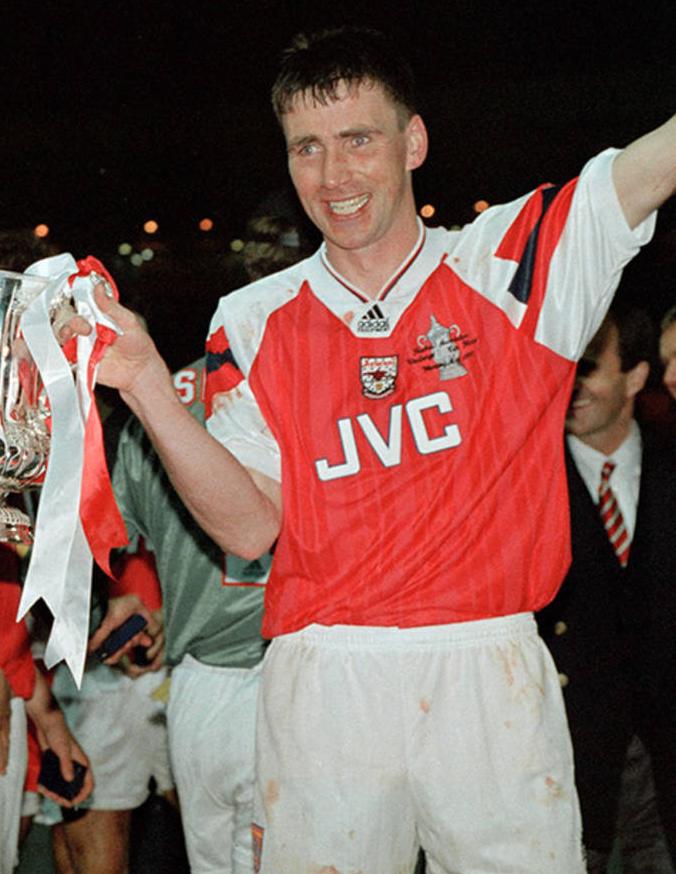
Arsenal's bruised banana Adidas kit from the 19911993 seasons holds a special place in the hearts of fans, representing an iconic and unforgettable era. The kit featured a bold and striking yellow design with jagged black brush stroke patterns, making it one of the most distinctive and instantly recognizable kits in football history. This audacious design perfectly captured the energy and confidence of Arsenal during that period.
The bruised banana kit is closely associated with the team's attacking prowess and their ability to dismantle opponents with flair and style. Players like Ian Wright, Tony Adams, and Dennis Bergkamp donned this iconic kit as they dazzled fans with their skill and led Arsenal to victory. The bruised banana Adidas kit symbolizes an era of excitement, innovation, and success, and it remains an enduring symbol of Arsenal's unique identity in the world of football. The partnership between Arsenal and Adidas in
the 1980s was a defining chapter in the club’s history. Through innovative kit designs, unprecedented success on the pitch, and a growing global fanbase, this collaboration played a crucial role in shaping Arsenal’s identity as a powerhouse in English football. The legacy of that era continues to inspire the club, driving its pursuit of greatness as Arsenal embraces new partnerships and opportunities while staying true to its rich heritage.
1991/93
